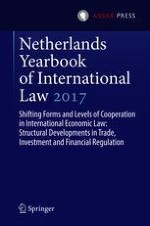2018 | OriginalPaper | Chapter
6. The Evolving Role of Sub-National Actors in International Economic Relations: Lessons from the Canada-European Union CETA
Author : Ohiocheoya Omiunu
Published in: Netherlands Yearbook of International Law 2017
Publisher: T.M.C. Asser Press
Activate our intelligent search to find suitable subject content or patents.
Select sections of text to find matching patents with Artificial Intelligence. powered by
Select sections of text to find additional relevant content using AI-assisted search. powered by
